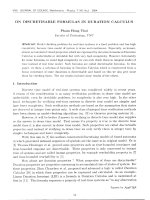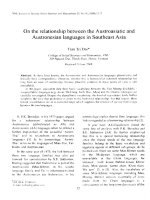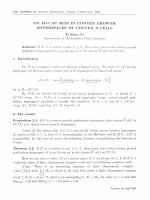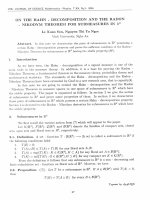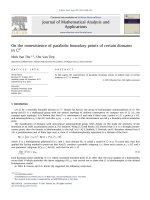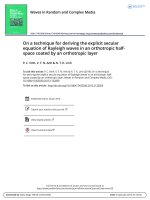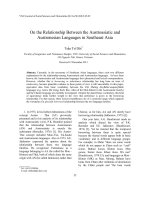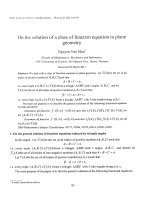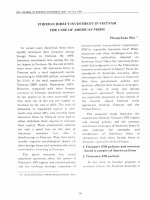DSpace at VNU: On fd-cap sets in convex growth hyperspaces of convex n-cell
Bạn đang xem bản rút gọn của tài liệu. Xem và tải ngay bản đầy đủ của tài liệu tại đây (1.48 MB, 5 trang )
VNU. JOURNAL OF SCIENCE. Mathematics - Physics. T .XVIII, N(,3 - 2002
O N F D -C A P S E T S IN C O N V E X
HY PERSPA CES
OF CONVEX
GROW TH
N -C E L L S
Ta K hac C u
D e p a rtm e n t o f M a th e m a tic s, V in h U n iversity
A b s tr a c t I f X is (I convex n-cell, n > 2. then every n o n -triv ia l convex growth
polyhedron hyperspace G is an fd-cap set in the closure c o f G in C C { X ) .
1. I n tr o d u c tio n
Let X be a compact convex set lying in a Banach space. We write C C { X ) for the
hyperspace of ail non-fimptv convex sets in X topologized by Hausdorff metric:
for■A t B e C C ( X ) .
By P ( X ) we denote the family of all convex polyhedrons in X . A family G c
C ' C ( X ) (resp. G c P ( X ) ) is n convex growth hypcrspacr ( 7'csp. convex growth poly
hedron hyperspace) provided it satisfies the condition: If’ A c G and B € C C ( X )
(rc.sp. D 6 P ( X ) ) such th at A c B. then D c G.
2. T h e r e s u lts
P r o p o s itio n 2.1. I f G is a co n vex g ro w th p o lyh ed ro n h yp crsp u cc th r u closure G o f G in
c c (X ) is a closed co n vex g ro w th hyperspace.
C urtis [2] has shown th at if G is a non-triviạl closed convex growth hyperspace
of convex n-cell, n > 2. then G is homeomorphic to the H ilbebrt cub Q iff G \ {X} is
contractible. In this note we prove the following theorem strengthening the theorem of
Curtis.
T h e o re m 2.2. I f X is a co n vex n-cell, n > 2, th en e ve ry n o n -triv ia l co n vex g ro w th
p o lyh ed ro n h y p ersp a ce G is an fd-cap s e t in th e closure G o f G in C C ( X ) .
Here we say th a t a subset M of a metric space X is an fd -ca p se t in X iff M is a
countable union of finite dimensional compact 2-sets and the following condition hold
{C ap.) T here is an increasing sequence of finite dimensional compact
2-sets { M n } with
I^J M n is dense in M such th at given a finite dimensional compact
n
€
N
set K c A\Ve > 0, n G N , there is an embedding h : K -» M m for some m > n such th at
h \ K n M x = i d and d(h(: r),x ) < e for each X e K .
T ypeset by
Ta K hac Cu
6
D e fin itio n 2.3. W e say th a t M is a cap-set in X iff M is a c o u n ta b le union o f co m p a ct
z~sets and the above co n d itio n is sa tisfied for e very fin ite d im en sio n a l c o m p a c t set K c X .
Combining the theorem with the result of Curtis [2] we obtain the following fact.
C o ro lla ry 2.4. L e t G be a noil-trivia l co n ve x g ro w th p o lyh ed ro n h y p e rsp a c e o f a convex
11-cell X , n > 2 and let G d e n o te th e closure o f G
in C C ( X ) . I f G \ {X} is co n tra ctib le ,
then ( G j G ) — ( Q , Q * ) , w here Q f = {x = (Xi) e Q : Xx = 0 f o r a lm o s t i} .
3. P r o o f o f t h e t h e o r e m
For each n € /V, put
Gn = { A e G : V A < n }
Fn = { A e G : A c I n t x
and V A < n},
where V.4 denotes the number of vertices of A . Obviously, Grx, Fn are 2 -sets in G for each
n e N and G D F = u
Fn , G = Ị J G n and G = T { = C C ( X ) ) .
nÇN
n€N
The proof of the theorem is divided into two steps.
S te p 1. Given e > 0, n £ N and a finite dimensional compact set K c G, there is a map
(J : K —> Fp , for some p > n such th at
OÎKnFn = r á a n d
< £/ 2
for X E K .
Proof. Take an ra > n such th a t Fm is an
—n e t for K . Let { U j y C j } j £ j be a Dugundji
system forK \ F m(see [1j) and let u = { U j } j € J i
= clim .
By N ( U ) we denote the nerve of u and let N o (Ư) be the 0-skeleton of N ( U ) . Since
dim K — k, we may assume that, every simplex <7 of N { U ) has at most k + 1 vertices. We
define
/ : N 0 ( U) -> F m
by the formula /(Ợ j) = dj for every j € J , and extend / over the 1-skeleton N \ ( U ) of
N ( U ) as follows:
Let c be edge of iV(t/) with endpoints UiyUj and m idpoint c * . We define / on
c = [U ,c*] u [C*, Uj] by the formula
/[(1 - t)U i + tc * ] =
Conv{at ,( l - t)di + t d j } ,
/[( 1 - t ) Uj + £C*] =
C onv{aj, (1 - i)a^ + tat},
for f G [0,1]. I t is easy t o s e e t h a t f ( x ) € i*2m2 for eac h X € c = [t/i, f/j).
We now extend / over N ( U ) .
Let c denote the hyperspace of subcontinua of the 1-skeleton of N ( U ) . Take a map
: N ( U ) —> c such th at tp(x) = {x} for each X € N \ { U ) ) and if G is the carrier of point
X, then ip(x) c
O n F D -ca p s e ts in v o n v e x g ro w th h y p ersp a ce s . . .
7
We define / : N ( U ) —> F by the formula
f ( x ) = C o n v { f ( p ) : p e tp{x)} for X e N ( U ) .
It is easy to see th at / is continuous (i.e. f / ơ is continuous for every simplex a of N ( U ) )
and f { x ) € /*2/bn2 for every X € K .
Let p = 2 k m 2, we define Í/ : .fir -* Fp by the formula
if X G K n Fm
ỡ(z) =
where
ư =
if X € K \ F m ,
/
is a locally finite
Since m > 71, we have
partition
of
unity
inscribed
into
ffl KnF„ = id.
For each X e K \ F m, let
E { x ) = {j € J, Aj(x) > 0}
Then cardJS(x) < Ả: + 1 and
d |p (i),* | = d
/
5^
\j€E(*)
/
< d [Conv {flj : j 6 £ (x )} , z] <
< sup{ d(aj,æ ) : j G £ (x )} < 2d(Fm,x).
This shows th a t 3 is continuous.
Since F m is an -£■ —net for A', we infer th at d ( q ( x ) , x ) < ~ for X € K .
4
2
S te p 2. There is an embedding h : K -> F m for some m > p > n such th at
h\K nF n = g ix n F ^ = id
and
d (/i(x ),s(x )) < ị e
for each X € K .
Proof. W ithout loss of generality we may assume th at X c R 2. Let us put
k =
ỊJ{s(x) : x € K } C
IntX.
Since K is compact, dist(ií,Ỡ A ‘) > 0, where d X denotes the boundary of X .
Let h be an embedding of K into I h . For some k € TV, let h X) i = 1 , . . . ,fc be the
it’s coordinate functions h.
Ta K h a c C u
8
For each
X
G
K,
put
2n Xj i
S ( x ) = Conv < e 3p { k + 1 ) ) j = 0 , . . . , 3 p ( k + l ) - 1
(1)
i2 =
(2)
-1
f
We défini' h. : K
if j = r ( k 4- 1) for r = 0 , . . . , 3p ( k + 1) — 1
j
j 4- ^ h g ( x )
if j = r(fc + 1) + q for r = 0 , . . . , 3p ( k + 1) — 1,
(3)
q = 1, . . . ,fc.
F by the formula
/i(æ) = g ( x ) + <5d(£, D ) S ( x )
for each X e K ,
where
5 = Fn n K
Ổ = ~ min Ịe , dist(K \Ỡ X ) j .
It is easy to see th a t
M * ) c Fn
for m = 3p(fc 4- 1), /i|ff = ỡ I b =
a n d d [/i(:r),p (x )] < “ for e a c h X € K .
Let us show th a t h is an embedding. Given x ,y € K w ith X ỹé y.
Consider three case.
C ase 1. x y y 6 D = K n F n . T hen we have
Mas) = 5 ( 1 ) = X î y - g( y) = h ( y ) .
C ase 2. X € B and y € K \ B . T hen we have
v /i(x ) = v
V < (v g(J ) ~ 2)2?r
Vg ( x )
'
where V denotes the angle of Ig ( x) at V.
Let V * denote the angle pictured as in figure 1.
h=£d(x,B)
F ig u r e 1
(4)
O n F D -ca p se ts i n v o n v e x g ro w th h y p e r spaces . . .
9
Then we have
V* = 2 7T - V
>
Vg(x)
p
111 this case h( x ) has at least
47T 3p { k -f 1)
= 6 (A: 4- 1 ) vertices of the form
p
2n
2 nXj i
V + Sd(x, D) ■e 3 p (fc +
, j = q , . . . , Ợ + 6 (fc + 1
Consider two cases.
Ca.se 3a. V is a vertex of y{y)- Since X 7^ y, from (1), (2), (3), (4) follows that
there are at least nine points of the form (5). which are not vertices of h( y) . This shows
that h ( x ) Ỷ h{y).
Case 3b. V is not a vertex of (j(y)y whence h( y ) has a t m ost two vertices of the
form (5), thus h( x ) Ỷ h(y)Thus h is one-to-one.
Since K is com pact, it follows th a t / is an
embedding.
This completes the proof of the theorem.
References
1. c . Bessaga and A. Petezynski, Selected topics in in fin ite d im e n sio n a l topology ,
Warszawa 1975.
2. D. w . Curtis, Growth hyperspaces of peano continua, Trans. A m e r. M ath. Soc.
(1978).
3. Nguyen To Nhu and Ta Khac. Cu, Probability measure functors preserving the ANRproperty of metric spaces, Proceedings o f A m e r. M ath. Soc. Vol. 106, No.2(1989).
4. Ta Khac Cu, Direct lim its which are pre-H ilbert spaces, A c ta . M a th . V ie tn a m ,
No.2(1989).
